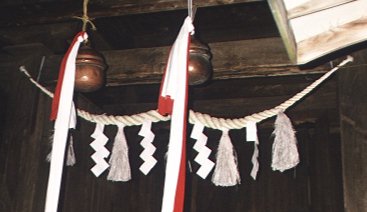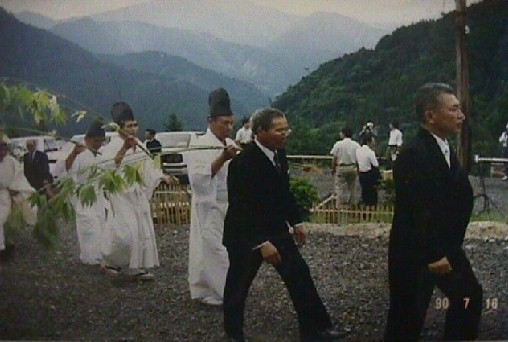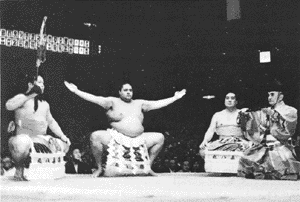|
|
Hemp has an important function in the mythology of Shinto,
the "Way of the Gods",
as the ancient indigenous religion
of Japan is known. Hemp was used to
purify, to drive out evil (exorcism). Hemp seeds were used in Shinto
marriage ceremonies. In some ceremonies hemp leaves were burnt as an
"invitation to the spirits".
(Moore)
Even today there are shinto ceremonies at major shrines such as
Ise Jingu in Mie prefecture and other shrines that involve the burning of taima (marijuana).
The priests' clothes were made from hemp linen and and bell ropes
in shrines (see image to the right) were made from hemp too. Hemp
for bell ropes is still grown in Nagano prefecture today.
Several hemp fields are cultivated on Shikoku (one of the four
main islands of Japan) to make ceremonial linen clothes for the
Imperial family and for Shinto priests.
|
|

Hempen bell rope
|
|

Hempen rope, fibre and paper in oldest shrine in Saitama
|

Hempen paper and raw fibre
|
Hemp fibre attached to a wooden stick called a gohei is
used in Shinto cleansing ceremonies, such as Shichigosan.
Hemp ropes and hemp paper are often seen as decorations
in shrines as they are believed to keep away evil.
At Japanese weddings so called Shishimai dragon dances are sometimes
performed. The thick white "hair" of these dragons is hemp fibre,
and so is the "hair" of fox masks and other costumes worn at
o-matsuri (festivals). The heavy carts pulled trough villages in
o-matsuri are pulled on hemp ropes.
Believers in Shinto sought the protection of a certain group of gods,
the Sahe no Kami: "Travellers prayed to them before setting out on a
journey and made a little offering of hemp leaves and rice to each
one they passed." (Moore)
We are not surprised that rice was a standard travel
fare, but this passage tells us that medieval Japanese used to travel
carrying hemp leaves, nowadays called marijuana.
If travellers were to practice their religion this way today
they could face as much as 5 years in prison.
|
"Another Shinto tale tells that every October, all the dieties from around Japan gather at a sacred site in rural Shimane prefecture (Sea of Japan side of Honshu, south of Tottori) at Japan's largest jinja (shrine) called Iizumo taisha. During this month, the rest of the nation is left unprotected from calamity while the Gods hold a harvest and match-making ritual celebration. Shimane-ken is far out of the way of any urban center and, besides being "Home of the Gods," it was the home to bounteous hemp harvests up until about 50 years ago."
Dave Olson
|
|
See also:

 An Overview of Shinto
An Overview of Shinto

 "Jinja Matsuri in ****-machi"
"Jinja Matsuri in ****-machi"
|
2. Liberation from Occupation!
|
From an interview with Pon (Yamada Kaiya)
"Well, the prayer given at the Ise Jingu, which is the shrine
to Amaterasu, the founding god of the imperial family, is called
taima, or marijuana. Hemp and rice are two sacred things which
are part and parcel of the rites conducted at Ise Jingu. This is
because hemp and rice were the
staple products of the Jomon and Yayoi cultures, respectively.
This means they were the most sacred things to these people.
The imperial tribe, which was an invading people, took possession
of these two sacred things and made them into instruments of control."
Yamada Kaiya
in the December 1995 issue of Jiyu Ishi
translated version in
Tokyo Observer 15

Emperor (left), priest, hemp fibre (right)
at funeral of Emperor's mother
|

|

|
3. Ise Shrine (ise jingu) in Mie prefecture
|
This is the main shrine of the the Amaterasu, the Sun Goddess.
Since the Japanese emperors claim to be her descendants it
is also the main shrine of Japanese Imperial family.

Five times a year so called "taima" (marijuana) ceremonies are
conducted at the shrine:
| January 8: | taima reki hôsei hajime sai |
| March 1: | taima reki hampu chûryû sai |
| Mid April: | taima reki yôzai kiri hajime sai |
| September 17: | taima reki hampu hajime sai |
| December 20: | taima reki hosei chûryû sai |
|
|

|

by George Foot Moore (1913)

Shinto priests carrying cannabis plants in the mountains of Gunma prefecture (1990)
Chapter I: Part II
To ward off ills caused by demons, especially the demons of
disease, the ancient Japanese sought the protection of a
particular group of gods, the Sahe no Kami, or "preventive
deities", who are invoked in an old liturgical text to defend
the worshippers against the "hostile and savage beings of the
root country," such as the "hags of Hades" who pursued Izanagi.
These deities were represented by phalli, often of gigantic size,
which were set up along highways and especially at cross-roads
to bar the passage against malignant beings who sought to pass.
In the liturgy referred to, one of these gods is called "No
Thoroughfare" (Kunado, or Funado), the name of the staff which
Izanagi threw down to prevent his pursuing spouse from breaking
out from Hades into the world above; two others are the prince
and princess of the eight cross-roads. They had no temples, and
were worshipped at the end of the sixth and twelfth months - the
time of the semiannual lustration - and on occasion at other
times, for example, on the outbreak of a pestilence.
The phallic form of the end post of a balustrade or a bridge has
a similar meaning; it keeps evil influence from passing. The
apotropaic virtue of this symbol - a virtue which it has in many
other countries, notably among the ancient Greeks - is due to the
association of virility with manly strength, power to overcome
invisible foes as well as visible, and to protect those in need
of help. Standing as they did on the roadside and at cross-roads,
these gods became the protectors of the wayfarers; travellers
prayed to them before setting out on a journey and made a little
offering of hemp leaves and rice to each
one they passed.
These gods had nothing to do, so far as the evidence shows, with
fertility or the reproductive functions; no peculiar rites were
observed in their worship, and however objectionable to the
taste of a more refined age, the cult was in no sense immoral
or conducive to immorality. In modern times, out of regard to
the prejudices of Europeans who connected obscene notions with
them, they have been generally removed from the roads, remaining
only in out-of-the-way corners of the empire.
(...)
Chapter II: Part II
From the 13th to the 15th of July an All-Souls feast is kept,
at which time it is believed that the souls are permitted to
return to their kindred and be entertained by them. A staging
of bamboo canes is erected in one of the rooms of the house,
on which food and lanterns are placed for the spirits, and a
Buddhist priest reads a mass before them.
On the first evening fires of hemp leaves are lighted
before the entrance of the house, and incense strewed on the
coals, as an invitation to the spirits. At the end of the
three days the food that has been set out for the spirits
is wrapped up in mats and thrown into a river. Dances of a
peculiar kind are a conspicuous feature of the celebration,
which is evidently an old Japanese custom; the Buddhist
elements are adscititious.
At this season the graves are decorated, and frequent visits
are paid by the kinsfolk. For those who have no relatives
living a mass is said in all the temples for
"the hungry devils."
Quoted from:
http://www.druglibrary.org/schaffer/hemp/hemprefs.htm

|

|


During the sumo ritual of dôyo-iri a yokozuna, the highest ranking sumo
wrestler, will ritually cleanse the dôyo (sumo ring) to exorcise evil,
wearing a hemp rope weighing several kg around his belly.
The choice of material is no coincidence. The reason for it is hemp's
association with purity, with driving out evil spirits. One such hemp
belt was presented by Japanese prime minister Obuchi to
French President Chirac, a sumo fan and, ironically, a staunch supporter
of marijuana prohibition.
|
6. Hemp in other religions
|
|
Islam:
The Koran prohibits Muslims from drinking wine but it
does not specifically mention any other intoxicants.
While some Muslim liberals say that what the prophet
really objected to was drunkenness, i.e. excessive drinking,
other, very conservative scholars claim that the prohibition
encompasses various kinds of substances, from opium to coffee.
Hemp was prohibited in Egypt on that basis, and so was coffee
in the Ottoman Turkish empire (see A
Chronology of Psychoactive Substance Use). In 1925
the Egyptian government asked England to support adding Indian
hemp to an international list of substances to be controlled.
The Egyptian government was opposed to alcohol too, but that
was not made illegal in Western countries. Opposition to
cannabis on religious grounds in Islamic countries has
essentially been based on narrow-minded dogma that
seeks to regulate all private pleasure in the name of
religion.
Many Islamic societies were tolerant of cannabis until international
politics forced them to copy western prohibition laws.
In Morocco cannabis became illegal in 1960 because the government was bribed
through large payments from foreign governments. The new law hasn't stopped
the cultivation, it has simply allowed the government and its officials
to accepts bribes from both sides.
Cannabis from Morrocco, Egypt, Lebanon, Persia (Iran), Afghanistan and India
was widely used in the Muslim world.
Soldiers of Napoleon Bonaparte brought back hashish from a war in
Egypt to 19th century France. The Mogul emperors of India who left us the
beautiful Taj Mahal were cannabis smokers too.
Cannabis is still widely grown and used in Islamic countries,
from the "kif" plantations of the Rif mountains in Morrocco to the jungles
of Aceh in Indonesia. Even draconic laws at certain times and in certain
countries have not been able to stamp out the custom.
Hinduism:
There is so much to be said about Cannabis in Indian religion that
we recommend studying the corresponding chapter of the
Report of the Indian Hemp Drugs Comission, published by the
British government when India was one of its colonies:
See also:

 Cannabis in Indian religion (http://www.druglibrary.org)
Cannabis in Indian religion (http://www.druglibrary.org)
Christianity:
There are no prohibitions against cannabis stated in the Bible, the
holy book of Christians.
According to the Book of Genesis which describes the creation of the
earth, God created all plants, which would include cannabis.
It states specifically that God gave humans "all plants bearing seeds"
for their use.
It is said that the Mexican word "marijuana" has a Christian origin.
"Maria" (Mary) and "Juan" (John) are the names of the mother and of one disciple of Iesus.
When he was crucified they were the only people not to desert him.
I think the idea behind this is that marijuana has often been used
by poor and disadvantaged people to make tolerable what is otherwise
hard to bear. In many countries marijuana was a drug of the poor (e.g. Jamaica,
South Africa, Egypt, USA before 1960s) while rich people drank alcohol.
Rich and powerful people have always been suspicious of poor people and
their habits.
See also:

 The War on Drugs is Un-Christian (http://www.olywa.net/when/)
The War on Drugs is Un-Christian (http://www.olywa.net/when/)

 Marijuana and the Bible (http://iahushua.com)
Marijuana and the Bible (http://iahushua.com)

 Cannabis and the Christ: Jesus used Marijuana (http://www.cannabisculture.com)
Cannabis and the Christ: Jesus used Marijuana (http://www.cannabisculture.com)
Rastafarianism
Rastafarianism is a biblical religion originating from Jamaica and the
Caribbean. It was popularized across the world by reggae musicians,
including Bob Marley (1945-1981). Cannabis was introduced into Jamaica
by Asian Indian plantation workers brought there to work the sugar
plantations after the end of slavery. Marijuana is still known by it's
Indian name "ganja" in Jamaica. Rastafarians consider smoking marijuana
a sacrament, like eating bread and drinking wine is during mass in
Christianity. As Rastafarianism has been more accepted into the
mainstream of Jamaican culture and has gained respect, the push for
legalisation of ganja in Jamaica has grown in strength.
A 1975 study by Rubin and Comitas, "Ganja in Jamaica"
found no demonstratable negative effects of cannabis use in Jamaica.
Users were socially well integrated, productive and healthy.
See also:
Ganja in Jamaica
1975 by Vera Rubin and Lambros Comitas
ISBN: 9027977313
|
7. Universal Declaration of Human Rights
|
Article 18.
"Everyone has the right to freedom of thought, conscience and religion; this right includes freedom to change his religion or belief, and freedom, either alone or in community with others and in public or private, to manifest his religion or belief in teaching, practice, worship and observance."
|
See also:

 Hemp for fibre, food and fuel,
as a "drug",
as medicine.
Hemp for fibre, food and fuel,
as a "drug",
as medicine.

 "Hempen Culture in Japan".
"Hempen Culture in Japan".

 "Hempen Culture in Japan": Religion.
"Hempen Culture in Japan": Religion.

 Hemp in Japanese History and Culture.
Hemp in Japanese History and Culture.
|


